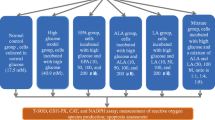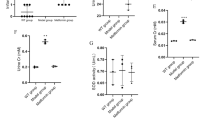Abstract
Hyperglycemia is a characteristic of diabetic nephropathy, inducing renal tubular cell apoptosis by eliciting oxidative stress and inflammation. Zinc (Zn) is known as an essential trace element in many enzymes and proteins involved in antioxidant defenses, electron transport, and exerting antiapoptotic or cytoprotective effects. In this study, the underlying mechanisms involved in the protective effects of Zn on high glucose-induced cytotoxicity were explored using cultured renal tubular epithelial cells (NRK-52E). The authors discovered that Zn supplementation inhibited high glucose (HG)-induced NRK-52E cell apoptosis by attenuating reactive oxygen species production, inhibiting HG-induced caspase-3 and caspase-9 activation, and inhibiting the release of cytochrome c from mitochondria to the cytosol. Further analysis revealed that Zn supplementation facilitated cell survival through increasing nuclear translocation of NF-E2-related factor 2 (Nrf2), leading to increased regulation of levels of two antioxidant enzymes, hemeoxygenase-1 and glutamate cysteine ligase, which provided an adaptive survival response against the HG-induced oxidative cytotoxicity. Moreover, the Zn-mediated increases in Nrf2 activity were suppressed by the pharmacological inhibition of Akt or extracellular signal-regulated kinase 1/2. Taken together, these findings suggest that Zn antiapoptosis capacity through the activation of Akt and ERK signal pathways leads to Nrf2 activation and, subsequently, Nrf2 target gene induction, thereby protecting the NRK-52E cells from HG-induced apoptosis.






Similar content being viewed by others
References
Lapice E, Pinelli M, Riccardi G et al (2010) Pro12Ala polymorphism in the PPARG gene contributes to the development of diabetic nephropathy in Chinese type 2 diabetic patients: comment on the study by Liu et al. Diabetes Care 33:e114, author reply e115
Ayodele OE, Alebiosu CO, Salako BL (2004) Diabetic nephropathy—a review of the natural history, burden, risk factors and treatment. J Natl Med Assoc 96:1445–1454
Verzola D, Gandolfo MT, Ferrario F et al (2007) Apoptosis in the kidneys of patients with type II diabetic nephropathy. Kidney Int 72:1262–1272
Kumar D, Zimpelmann J, Robertson S et al (2004) Tubular and interstitial cell apoptosis in the streptozotocin-diabetic rat kidney. Nephron Exp Nephrol 96:e77–e88
Kim YJ, Kim YA, Yokozawa T et al (2011) Pycnogenol modulates apoptosis by suppressing oxidative stress and inflammation in high glucose-treated renal tubular cells. Food Chem Toxicol 49:2196–2201
Ortiz A (2000) Nephrology forum: apoptotic regulatory proteins in renal injury. Kidney Int 58:467–485
Zhang Y, Wada J, Hashimoto I et al (2006) Therapeutic approach for diabetic nephropathy using gene delivery of translocase of inner mitochondrial membrane 44 by reducing mitochondrial superoxide production. J Am Soc Nephrol 17:1090–1101
Lau GJ, Godin N, Maachi H et al (2012) Bcl-2-modifying factor induces renal proximal tubular cell apoptosis in diabetic mice. Diabetes 61:474–484
Naziroglu M (2012) Molecular role of catalase on oxidative stress-induced Ca(2+) signaling and TRP cation channel activation in nervous system. J Recept Signal Transduct Res 32:134–141
Naziroglu M, Dikici DM, Dursun S (2012) Role of oxidative stress and Ca(2)(+) signaling on molecular pathways of neuropathic pain in diabetes: focus on TRP channels. Neurochem Res 37:2065–2075
Ganju N, Eastman A (2003) Zinc inhibits Bax and Bak activation and cytochrome c release induced by chemical inducers of apoptosis but not by death-receptor-initiated pathways. Cell Death Differ 10:652–661
Zhang X, Liang D, Ma J et al (2012) Zinc inhibits high glucose-induced apoptosis in peritoneal mesothelial cells. Biol Trace Elem Res 150:424–432
Karatug A, Kaptan E, Bolkent S et al (2013) Alterations in kidney tissue following zinc supplementation to STZ-induced diabetic rats. J Trace Elem Med Biol 27:52–57
Jansen J, Karges W, Rink L (2009) Zinc and diabetes—clinical links and molecular mechanisms. J Nutr Biochem 20:399–417
Wessel D, Flugge UI (1984) A method for the quantitative recovery of protein in dilute solution in the presence of detergents and lipids. Anal Biochem 138:141–143
Zhang X, Liang D, Chi ZH et al (2013) Zinc transporter 5 and zinc transporter 7 induced by high glucose protects peritoneal mesothelial cells from undergoing apoptosis. Cell Signal 25:999–1010
Zhang LY, Zhou YY, Deng YW et al (2011) Taurine inhibits serum deprivation-induced osteoblast apoptosis via the taurine transporter/ERK signaling pathway. Braz J Med Biol Res 44:618–623
Villeneuve NF, Lau A, Zhang DD (2010) Regulation of the Nrf2-Keap1 antioxidant response by the ubiquitin proteasome system: an insight into cullin-ring ubiquitin ligases. Antioxid Redox Signal 13:1699–1712
Martindale JL, Holbrook NJ (2002) Cellular response to oxidative stress: signaling for suicide and survival. J Cell Physiol 192:1–15
Nishiura T, Abe K (2007) Alpha1-adrenergic receptor stimulation induces the expression of receptor activator of nuclear factor kappaB ligand gene via protein kinase C and extracellular signal-regulated kinase pathways in MC3T3-E1 osteoblast-like cells. Arch Oral Biol 52:778–785
Singla N, Dhawan DK (2013) Zinc, a neuroprotective agent against aluminum-induced oxidative DNA injury. Mol Neurobiol 48:1–12
Chen H, Carlson EC, Epstein PN et al (2001) Overexpression of metallothionein in pancreatic beta-cells reduces streptozotocin-induced DNA damage and diabetes. Diabetes 50:2040–2046
Batista MN, Cuppari L, de Medeiros AC et al (2006) Effect of end-stage renal disease and diabetes on zinc and copper status. Biol Trace Elem Res 112:1–12
Soinio M, Marniemi J, Lehto S, Ronnemaa T (2007) Serum zinc level and coronary heart disease events in patients with type 2 diabetes. Diabetes Care 30:523–528
Kumar SD, Vijaya M, Watt F et al (2012) Zinc supplementation prevents cardiomyocyte apoptosis and congenital heart defects in embryos of diabetic mice. Free Radic Biol Med 53:1595–1606
Tripathi P, Koss B, Opferman JT et al (2013) Mcl-1 antagonizes Bax/Bak to promote effector CD4(+) and CD8(+) T-cell responses. Cell Death Differ 20:998–1007
Liang D, Yang M, Guo B et al (2012) Zinc inhibits H(2)O(2)-induced MC3T3-E1 cells apoptosis via MAPK and PI3K/AKT pathways. Biol Trace Elem Res 148:420–429
Meerarani P, Ramadass P, Toborek M et al (2000) Zinc protects against apoptosis of endothelial cells induced by linoleic acid and tumor necrosis factor alpha. Am J Clin Nutr 71:81–87
Bruinsma JJ, Jirakulaporn T, Muslin AJ et al (2002) Zinc ions and cation diffusion facilitator proteins regulate Ras-mediated signaling. Dev Cell 2:567–578
Wu W, Wang X, Samet JM et al (2003) Zinc-induced PTEN protein degradation through the proteasome pathway in human airway epithelial cells. J Biol Chem 278:28258–28263
Bao B, Prasad AS, Beck FW et al (2008) Zinc supplementation decreases oxidative stress, incidence of infection, and generation of inflammatory cytokines in sickle cell disease patients. Transl Res 152:67–80
Naziroglu M, Yoldas N, Uzgur EN et al (2013) Role of contrast media on oxidative stress, Ca(2+) signaling and apoptosis in kidney. J Membr Biol 246:91–100
Shih AY, Li P, Murphy TH (2005) A small-molecule-inducible Nrf2-mediated antioxidant response provides effective prophylaxis against cerebral ischemia in vivo. J Neurosci 25:10321–10335
Cho HY, Reddy SP, Yamamoto M et al (2004) The transcription factor NRF2 protects against pulmonary fibrosis. FASEB J 18:1258–1260
Leonard MO, Kieran NE, Howell K et al (2006) Reoxygenation-specific activation of the antioxidant transcription factor Nrf2 mediates cytoprotective gene expression in ischemia-reperfusion injury. FASEB J 20:2624–2626
Liu M, Grigoryev DN, Crow MT et al (2009) Transcription factor Nrf2 is protective during ischemic and nephrotoxic acute kidney injury in mice. Kidney Int 76:277–285
Yoh K, Hirayama A, Ishizaki K et al (2008) Hyperglycemia induces oxidative and nitrosative stress and increases renal functional impairment in Nrf2-deficient mice. Genes Cells 13:1159–1170
Fan Y, Chen H, Qiao B et al (2007) Opposing effects of ERK and p38 MAP kinases on HeLa cell apoptosis induced by dipyrithione. Mol Cells 23:30–38
Huang HC, Nguyen T, Pickett CB (2002) Phosphorylation of Nrf2 at Ser-40 by protein kinase C regulates antioxidant response element-mediated transcription. J Biol Chem 277:42769–42774
Zipper LM, Mulcahy RT (2000) Inhibition of ERK and p38 MAP kinases inhibits binding of Nrf2 and induction of GCS genes. Biochem Biophys Res Commun 278:484–492
Acknowledgments
This work was supported by the National Grand Fundamental Research 973 Program of China (2012CB722405), the Natural Science Foundation of China (81170561, 81170775), and the Shen Yang City Science and Technology Program (F11-264-1-21).
Author information
Authors and Affiliations
Corresponding author
Rights and permissions
About this article
Cite this article
Zhang, X., Zhao, Y., Chu, Q. et al. Zinc Modulates High Glucose-Induced Apoptosis by Suppressing Oxidative Stress in Renal Tubular Epithelial Cells. Biol Trace Elem Res 158, 259–267 (2014). https://doi.org/10.1007/s12011-014-9922-x
Received:
Accepted:
Published:
Issue Date:
DOI: https://doi.org/10.1007/s12011-014-9922-x




